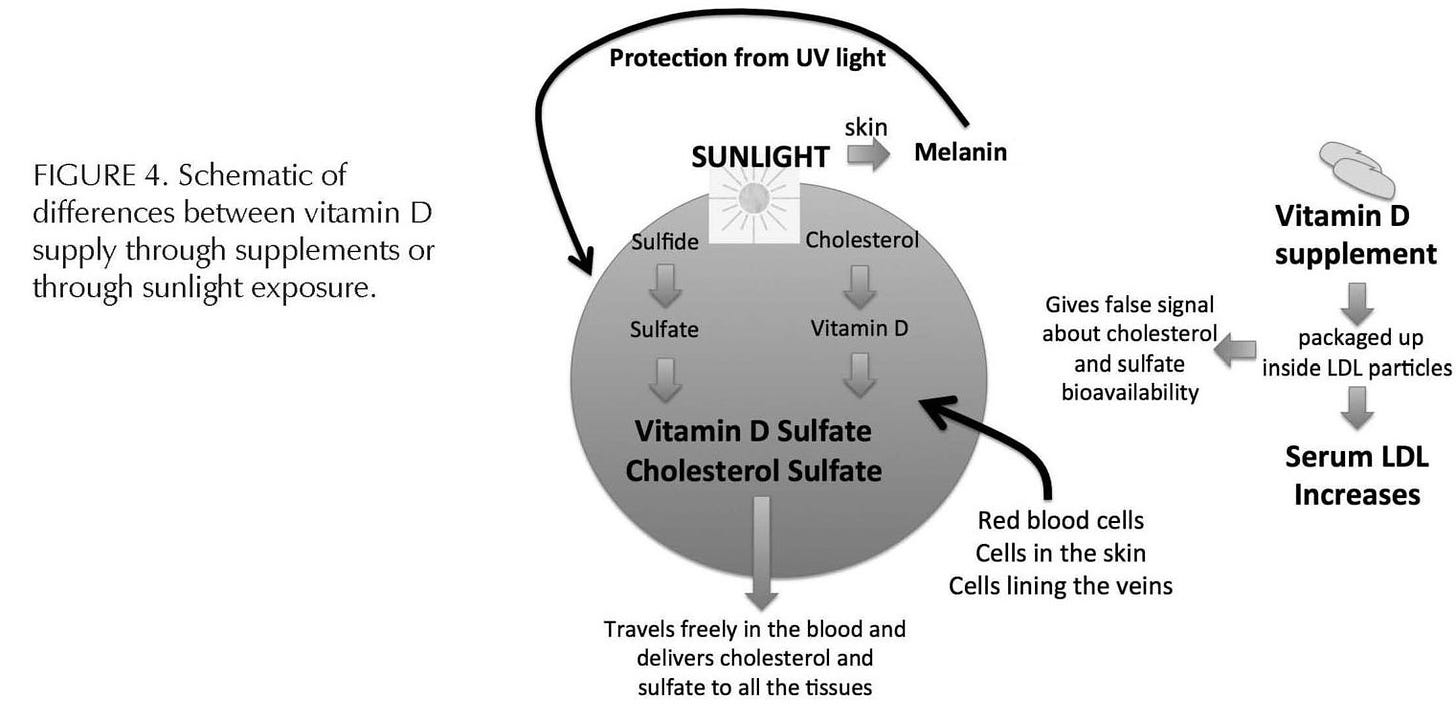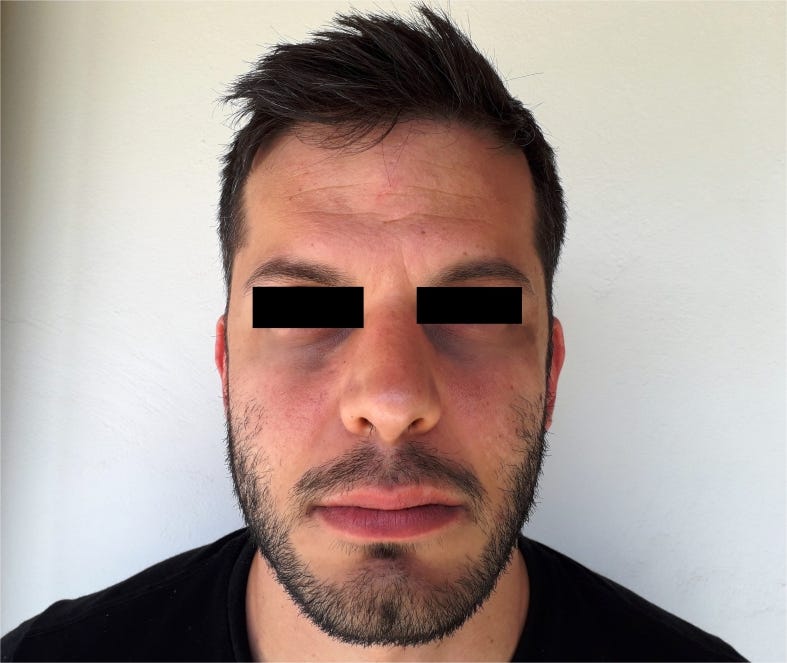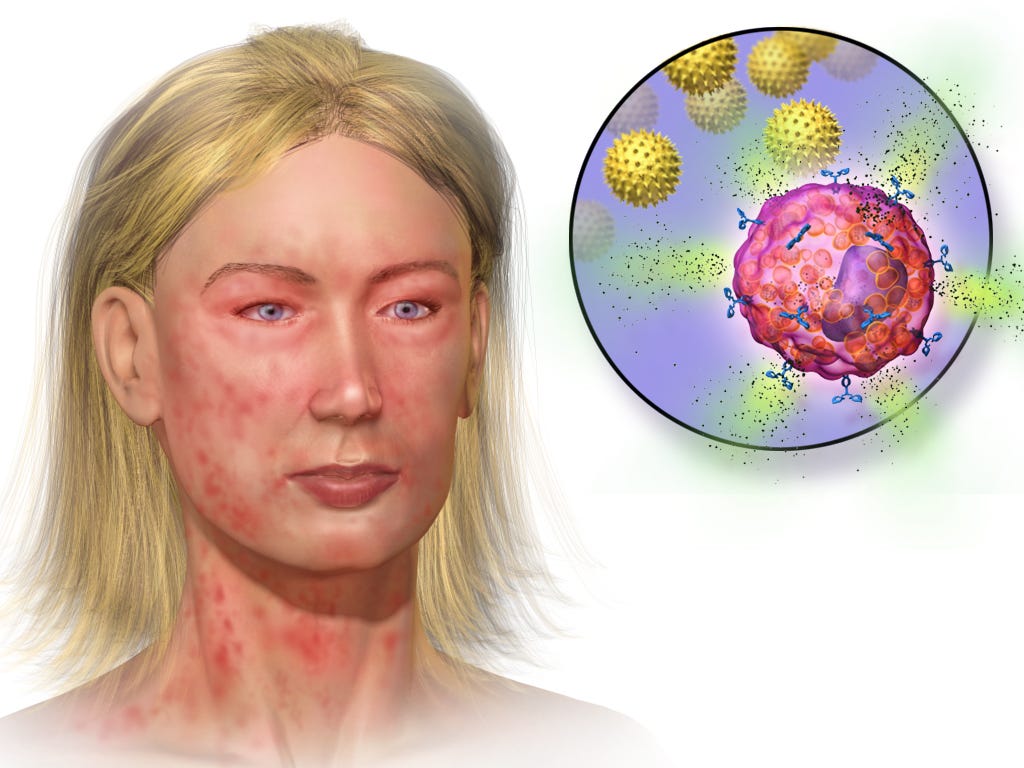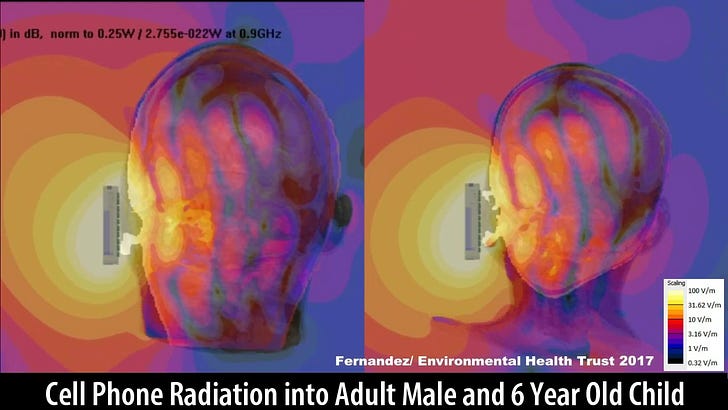All articles are free. However, your support as a paid subscriber enables us to continue producing high-quality, independent research on important health topics like EMF.
As an ad-free platform, we rely on the support of our readers to keep this content accessible and free from external influence.
Here’s what you’ll learn in this article:
1. How do we heal our skin with Sunlight?
2. Can screens cause dermatitis?
3. How does our face react when we play too many video games?
4. How was screen dermatitis discovered?
5. JOIN the waitlist: EMF 101 Course
Have you ever been diagnosed with eczema or rosacea?
What if I told you that rash on your face means that you may need to reverse your prescription of staying indoors under excessive blue light, and exposing yourself to more Sunlight instead?
How do we heal our skin with Sunlight?
The building blocks of life are proteins. Proteins are made of amino acids. Amino acids are made up of peptides. Why is this important for our skin?
The active form of vitamin D (1,25-Dihydroxyvitamin D3), not the storage version (D25 OH), regulates how we make expression of antimicrobial peptide cathelicidin, not only in our white blood cells but also in our epidermis, the outermost layer of our skin.
Cathelicidin has been studied for its role in wound healing1 and skin diseases as diverse as psoriasis, rosacea, and dermatitis.
The optimal way for our bodies to make the active form of vitamin D is through Sun exposure.
When we take supplements, this can send a false signal to our tissues that the amount of vitamin D is plentiful, leading to a cascade of health harm.

Vitamin D is made from LDL cholesterol when we expose ourselves to UV-B light. How can we absorb more UV-B without getting a sunburn?
Pre-load our skin with infrared and red light in the AM. I give a formula for those with a paler complexion in this article:
You also won’t be able to absorb UV-B if you wear sunscreen of course.
If you’re interested in the history behind sunscreen, and how UV became demonized, check out:
Can cell phones and monitors cause dermatitis?
Olle Johansson, associate professor and head of the Experimental Dermatology Unit, Department of Neuroscience, at the Karolinska Institute (famous for its Nobel Prize in Physiology or Medicine) in Stockholm, Sweden, is a world-leading authority in the field of EMF radiation and health effects.
Johansson has published more than 500 original articles, reviews, book chapters and conference reports within the field of basic and applied neuroscience.
In one of several related studies2, Johansson found a profound increase in mast cells in facial skin samples from people with this form of EHS. (electrohypersensitivity). Mast cells regulate our immune response and play a key role in the inflammatory process.
“For me, it was immediately clear that persons claiming skin reactions after having been exposed to computer screens very well could be reacting in a highly specific way - especially if the provocative agent was radiation — just as you would do if you had been exposed to sun rays, X-rays, radioactivity or chemical odors.”
-Olle Johansson
Video gamers got no game
In 2021, the International Journal of Pediatrics & Adolescent Medicine published a study3 that advised dermatologists to “consider video games with a high index of suspicion when encountering [skin disease] in underage patients engaging in persistent gaming behavior.”
“As video games become increasingly advanced and immersive, various cutaneous conditions arising from intensive gaming will likely become common over time.”
-Georgia Kyriakou,
Department of Dermatology, University General Hospital of Patras
When we expose our skin to screens, it responds by creating more melanin. Melanin is a miracle pigment molecule that fights cancer by absorbing UV (ultraviolet) radiation, and turning it into heat our bodies can use.
Like cholesterol, melanin fights inflammation. When we are creating too much, a condition known as hyperpigmentation arises. Hyperpigmentation is also caused when we’re deficient in B12, which is not only a vitamin, but a photoreceptor that is depleted by blue light.4 5

If you’re trying to attract the opposite sex, you may want to ditch the video games, and start playing the Game of life!
Full disclosure: I used to play a lot of video games as an 80s child, but they were much less intense.
The origins of “screen dermatitis”
The following is an article by
, which gives an overview of how Johansson first detected the origins of screen dermatitis:“In the 1970s the newspaper industry was one of the first to supply its employees with computers. Complaints of visual problems and headaches, as well as clusters of miscarriages and birth defects in children born to female editors and other newspaper employees, generated some publicity.
In the United States, then-Representative Al Gore held Congressional hearings in 1981 on the health effects of computer screens. In Sweden, a union activist brought the problem to the attention of Dr. Olle Johansson, a neuroscientist at the world-renowned Karolinska Institute. Johansson was the head of the Experimental Dermatology Unit at the Institute.
“For me,” said Johansson, “it was immediately clear that persons claiming skin reactions after having been exposed to computer screens very well could be reacting in a highly specific way and with a completely correct avoidance reaction, especially if the provocative agent was radiation and/or chemical emissions — just as you would do if you had been exposed to e.g. sun rays, X-rays, radioactivity or chemical odours.”
Johansson began to study the skin of these patients, and proved that they had a real skin condition that was provoked by sitting in front of a computer screen. The damage was similar to that caused by ultraviolet radiation from the sun. He also showed that the radiation from computers causes measurable changes even in the skin of “normal” people, and also in the skin of laboratory animals.
He named the new disease “screen dermatitis.” However, since such individuals also usually complained of other symptoms, such as chest pain, memory loss, fatigue, insomnia, dizziness, nausea, and headache, the more general term “electromagnetic hypersensitivity” came into use.
Many people who worked in the electronics industry in Sweden, including an estimated 12% of the electrical engineers in that industry, became electrically sensitive, and helped form an organization called Föreningen för el-och bildskärmsskadade (Association for the Electrosensitive), or FEB. Due in part to the work of FEB and the research of Dr. Johansson, electrosensitivity is a fully recognized disability in Sweden.
More recently, Johansson and his colleagues have conducted important epidemiological studies showing that wireless communication networks are causing significant illness throughout society. They have also shown that increased rates of asthma as well as certain types of cancer were strongly correlated with exposure to radio broadcasting during the twentieth century.
“The world may be moving inexorably,” Johansson warns, “toward one of those tragic moments that will lead historians to ask: Why did they not act in time?”
Do you know anyone with a "mysterious" face rash? If so, please send them our way!
Thank you so much for taking the time to read and support our work.
You are more powerful than you know.
and
If you’ve found this article valuable, please consider sharing it with loved ones.
Want to take proactive steps in your health?
We’re creating a course on EMF!
How can we measure EMFs in our environment?
What are other sources of electricity we may have forgotten about, like piping in our homes?
What are some other ways we can nourish the electric field of our body?
I’ll be covering these types of specifics, along with practical steps we can take to reduce EMFs in our daily lives, in the Wireless Health & Safety course I’m creating.
Start educating yourself today with ancestral strategies!
Check out our 5-Part series on how to treat damage from EMF.
EMF Health Forum: Please share your story
If you suspect that you or your animals are suffering from symptoms related to EMF, I strongly encourage you to register and post symptoms on EMF Health Forum, which I recently created to track the global fallout from wireless radiation:
Support Decentralized Medicine: Donate in Bitcoin
Send to our BTC Address!
bc1qfwtn8f95z7urkgfgj8c9t6dt3lay0shtgazr72
The new 5G meter by Safe Living Technologies is out!
Additional Resources:
Articles by Olle Johansson:
“MYSTERY IN THE SKIN. Screen dermatitis, the effect of computer work on human skin.” An interview with Olle Johansson, 2001
https://www.salzburg.gv.at/gesundheit_/Documents/feb_mystery_in_the_skin.pdfhttp://www.feb.se/ARTICLES/OlleJ.htm
MALIGNANT MELANOMA OF THE SKIN – NOT A SUNSHINE STORY!
https://avaate.org/IMG/pdf/melanoma_fm.pdf
Wang G, Chen Z, Tian P, Han Q, Zhang J, Zhang AM, Song Y. Wound healing mechanism of antimicrobial peptide cathelicidin-DM. Front Bioeng Biotechnol. 2022 Nov 7;10:977159. doi: 10.3389/fbioe.2022.977159. PMID: 36425652; PMCID: PMC9681526.
Johansson O, Hilliges M, Björnhagen V, Hall K. Skin changes in patients claiming to suffer from "screen dermatitis": a two-case open-field provocation study. Exp Dermatol. 1994 Oct;3(5):234-8. doi: 10.1111/j.1600-0625.1994.tb00282.x. PMID: 7881769.
Kyriakou G, Glentis A. Skin in the game: Video-game-related cutaneous pathologies in adolescents. Int J Pediatr Adolesc Med. 2021 Jun;8(2):68-75. doi: 10.1016/j.ijpam.2019.09.002. Epub 2019 Sep 6. PMID: 34084875; PMCID: PMC8144863.
Mori K, Ando I, Kukita A. Generalized hyperpigmentation of the skin due to vitamin B12 deficiency. J Dermatol. 2001 May;28(5):282-5. doi: 10.1111/j.1346-8138.2001.tb00134.x. PMID: 11436369.
















Dear subscribers - my wife and I are taking the time to unplug and camp out this week. We appreciate your comments and will get back to you next week! - Roman and Bohdanna
I suspect it is fungal - lots of links between these skin issues and various types of fungus - and fungus are sensitive to types of light - both blue and red are needed to kill them, while some blue light frequencies alone can make them grow. These skin issues on the face are also highly correlated with Parkinson's - whenever I am more symptomatic than normal, I can tell it by the inflammation of skin on my face. Some of these fungus are known to eat l-dopa the precursor to dopamine, and deposit alpha-synuclein the misfolded protein associated with pd, and so there is a school of thought that these fungal infections are causal of pd, and hence anything which makes the fungus worse will increase the symptoms. This will include too much screen use, according this...